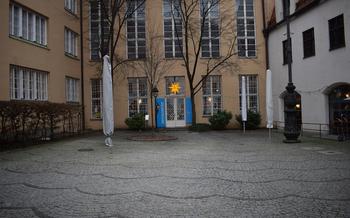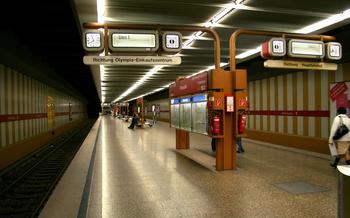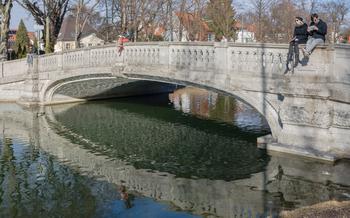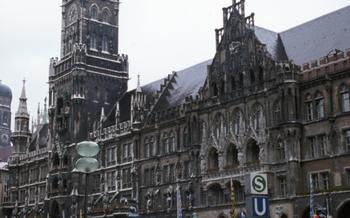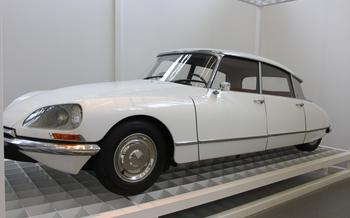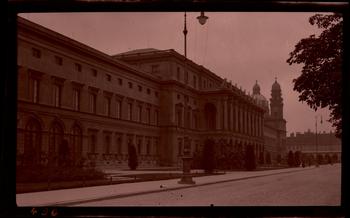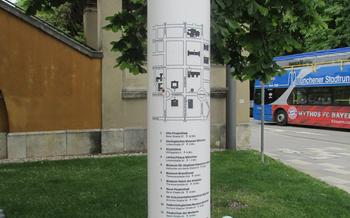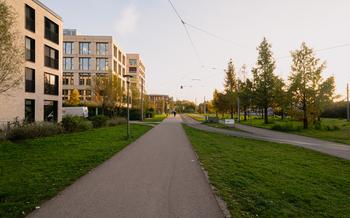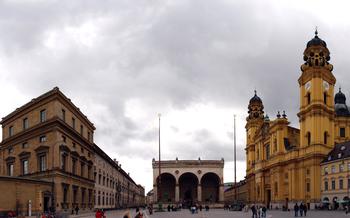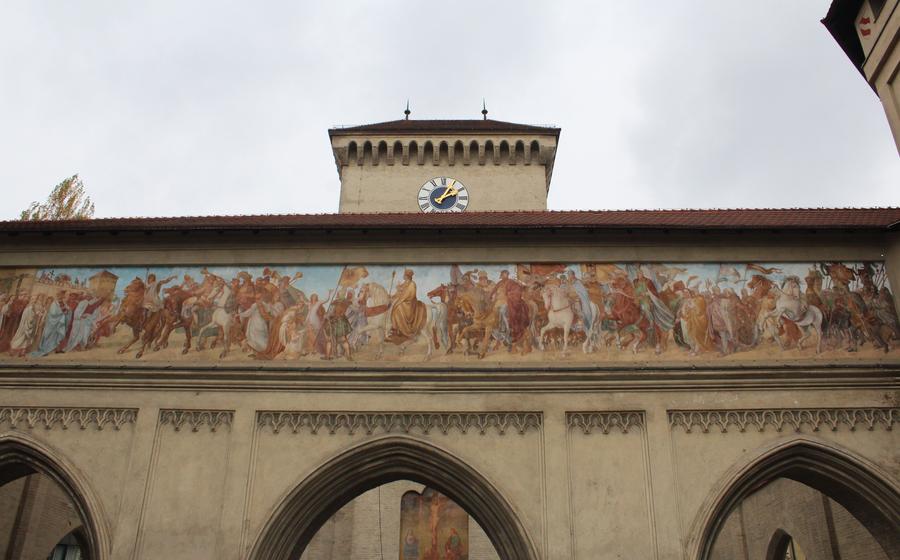
Isartor
- The Isartor: A Monumental Gateway to Munich's Past
- A Journey Through Time: Exploring the Isartor's History
- Architectural Marvel: Unveiling the Isartor's Design
- A Tale of Two Towers: Ascending the Isartor
- The Isartorplatz: A Vibrant Square with a Rich Past
- Landmark Hotel: The Bayerischer Hof, a Symbol of Elegance
- Cultural Hotspot: The Deutsches Museum, a Journey into Science and Technology
- Extensive Exhibits: A World of Discovery
- Interactive Displays: Engaging the Senses
- Hands-on Experiences: Igniting Curiosity
- Artistic Haven: The Isarphilharmonie, a Symphony of Sounds
- Shopping Paradise: Kaufingerstraße, a Retail Haven
- Culinary Delights: Viktualienmarkt, a Feast for the Senses
- Green Oasis: The Isar River, a Natural Escape
- Insider Tip: Take a break at the Flaucher, a popular riverside spot
- Royal Legacy: The Residenz, a Palace of Splendor
- Cultural Tapestry: The Alte Pinakothek, a Masterpiece Gallery
- Contemporary Art Haven: The Pinakothek der Moderne, a Showcase of Innovation
The Isartor: A Monumental Gateway to Munich's Past
In the heart of Munich, Germany, stands the Isartor, a monumental gateway that has borne witness to the city's rich history for over 700 years. This iconic landmark, with its twin towers and intricate Gothic details, is not just a symbol of Munich's architectural heritage but also a reminder of its resilience and evolution.
The Isartor was built in the 14th century as part of Munich's second city wall, serving as a defensive fortification and a gateway for trade and travel. Its strategic location on the banks of the Isar River, from which it derives its name, made it a crucial entry point to the city.
Over the centuries, the Isartor has undergone various transformations, reflecting Munich's changing needs and aspirations. From a fortified gate to a customs house and eventually a cultural center, the Isartor has adapted to the city's growth and development, becoming an enduring symbol of its rich past.
A Journey Through Time: Exploring the Isartor's History
The Isartor's story begins in the Middle Ages, when Munich was a small town surrounded by defensive walls. The gate was built in the 14th century as part of the city's fortifications, serving as a strategic point of entry and exit. It was designed to withstand attacks and protect the city from invaders, and its sturdy construction has allowed it to remain standing for centuries.
Over time, the Isartor's role evolved. As Munich grew and expanded, the walls surrounding the city were gradually demolished, and the gate lost its defensive purpose. However, it continued to serve as a city gate, controlling the flow of goods and people into and out of the city. The gate was also used as a customs house, where merchants paid taxes on their goods.
In the 19th century, the Isartor underwent a major renovation, which restored it to its former glory. The gate was repaired, its towers were raised, and its facade was adorned with intricate decorations. The renovation was completed in 1860, and the Isartor was officially opened to the public.
Today, the Isartor stands as a testament to Munich's rich history. It is one of the few remaining medieval gates in the city, and it has become a symbol of Munich's past. The gate is a popular tourist destination, and visitors can climb to the top of its towers for stunning views of the city.
Architectural Marvel: Unveiling the Isartor's Design
The Isartor's architectural grandeur is a testament to the city's rich history and artistic heritage. Built in the 14th century, the gate's design showcases a harmonious blend of Gothic and Renaissance elements, reflecting the transition between medieval and modern times.
The Isartor's most striking feature is its twin towers, which soar majestically over the surrounding cityscape. The towers are adorned with intricate carvings, pinnacles, and gargoyles, creating a sense of awe and wonder. The gate's facade is further embellished with sculptures and reliefs depicting scenes from mythology and history, adding to its visual appeal.
The Isartor's design also incorporates several defensive features, such as machicolations and arrow slits, which were essential for protecting the city from attackers. The gate's sturdy construction and impressive height made it a formidable obstacle for any invading force.
Overall, the Isartor's architectural design is a masterpiece of medieval engineering and artistry. Its intricate details, imposing towers, and historical significance make it a symbol of Munich's rich cultural heritage.
A Tale of Two Towers: Ascending the Isartor
Venturing beyond the Isartor's imposing facade reveals a world of history and enchantment. Ascend the winding staircases of the twin towers, each step carrying you further back in time. The walls whisper tales of medieval grandeur, battles fought, and triumphs celebrated.
At the summit, a breathtaking panorama of Munich unfolds before your eyes. The city's landmarks, like glittering jewels, dot the cityscape, each with its own story to tell. Gaze upon the spires of the Frauenkirche, the majestic silhouette of the Deutsches Museum, and the verdant expanse of the Englischer Garten.
Within the towers, the Isartor Tower Museum beckons with its collection of historical artifacts, shedding light on the Isartor's past as a defensive bastion, a city gate, and a customs house. Intriguing exhibits transport you to different eras, allowing you to experience the Isartor's evolution firsthand.
Whether you choose to marvel at the panoramic vistas, delve into the depths of history, or simply soak in the atmosphere, the Isartor's towers offer a unique and unforgettable experience.
The Isartorplatz: A Vibrant Square with a Rich Past
In the heart of Munich, where the Isartor proudly stands, lies the Isartorplatz, a vibrant square steeped in history and bustling with life. This central gathering place has witnessed the ebb and flow of time, serving as a marketplace, a parade ground, and a meeting point for locals and visitors alike.
Surrounding the square are a host of historically significant buildings that tell the tale of Munich's rich past. The majestic Isartor, with its twin towers reaching towards the sky, dominates the scene, while the neighboring Heiliggeistkirche (Church of the Holy Ghost) adds a touch of spirituality with its Gothic architecture. The former Augustinerkloster (Augustinian Monastery) now houses the Deutsches Museum, a world-renowned institution dedicated to science and technology.
The Isartorplatz exudes a lively atmosphere, with locals and tourists mingling in its charming cafes, restaurants, and shops. The square often hosts vibrant markets, festivals, and cultural events, showcasing the city's diverse heritage and vibrant spirit. Whether you seek a leisurely stroll, a culinary adventure, or a glimpse into Munich's history, the Isartorplatz offers a captivating experience for all.
Landmark Hotel: The Bayerischer Hof, a Symbol of Elegance
In the heart of Munich's bustling city center, a majestic landmark stands as a testament to timeless elegance and hospitality: the Bayerischer Hof. With a history dating back to the 19th century, this grand hotel has played host to royalty, celebrities, and discerning travelers from around the world.
The Bayerischer Hof's architectural grandeur is a sight to behold. Its neo-Renaissance facade, adorned with intricate carvings and sculptures, exudes an aura of sophistication and charm. Inside, guests are greeted by a world of opulent splendor, with lavishly appointed rooms and suites, adorned with fine furnishings and artwork.
Beyond its luxurious accommodations, the Bayerischer Hof offers a culinary journey like no other. The hotel's Michelin-starred restaurant, Atelier, delights guests with innovative and exquisite cuisine, while the Blue Spa offers a sanctuary of relaxation and rejuvenation.
The Bayerischer Hof is more than just a hotel; it is a cultural institution, hosting prestigious events, exhibitions, and concerts throughout the year. Its elegant ballroom, the Königssaal, has witnessed countless memorable occasions, from lavish weddings to glittering galas.
For those seeking the epitome of luxury and sophistication in Munich, the Bayerischer Hof is the perfect choice. This iconic hotel offers an unforgettable experience, where history, elegance, and modern amenities converge to create a truly exceptional stay.
Cultural Hotspot: The Deutsches Museum, a Journey into Science and Technology
Nestled in the heart of Munich, the Deutsches Museum stands as a testament to Germany's rich scientific and technological heritage. Founded in 1903, this world-renowned institution houses an awe-inspiring collection of exhibits that span a vast array of disciplines, from aviation and space exploration to energy, transportation, and communication.
Extensive Exhibits: A World of Discovery
The Deutsches Museum's extensive collection offers an immersive journey through the wonders of science and technology. Visitors can marvel at the grandeur of historic aircraft, delve into the complexities of the human body, and witness the birth of groundbreaking innovations that have shaped our modern world. From the first steam engine to the latest advancements in robotics, the museum provides a comprehensive exploration of scientific achievements throughout the ages.
Interactive Displays: Engaging the Senses
The Deutsches Museum goes beyond mere observation, inviting visitors to actively engage with its exhibits. Interactive displays and hands-on experiences bring complex concepts to life, allowing visitors to explore scientific phenomena firsthand. Simulators, virtual reality experiences, and interactive installations create an immersive environment where learning becomes an exhilarating adventure.
Hands-on Experiences: Igniting Curiosity
The Deutsches Museum's commitment to hands-on learning extends beyond interactive displays. Visitors of all ages can participate in engaging workshops and demonstrations, where they can build their own circuits, conduct scientific experiments, and even pilot a virtual aircraft. These hands-on experiences ignite curiosity and foster a passion for science and technology, leaving a lasting impression on young minds.
Artistic Haven: The Isarphilharmonie, a Symphony of Sounds
Nestled in the heart of Munich's vibrant cultural district, the Isarphilharmonie stands as a testament to the city's rich musical heritage. This striking concert hall, designed by renowned architect Hans Scharoun, boasts a distinctive sail-like roof that has become a defining landmark of the city's skyline.
Completed in 1985, the Isarphilharmonie is renowned for its exceptional acoustics, which have made it a favorite venue for classical concerts, opera performances, and various musical events. The concert hall features two main auditoriums: the Great Hall with a seating capacity of over 2,000 and the Chamber Hall with a more intimate setting for smaller performances.
The Isarphilharmonie is home to the Munich Philharmonic Orchestra, one of Germany's leading orchestras, and also hosts numerous guest orchestras and soloists from around the world. The concert hall's diverse programming includes classical masterpieces, contemporary compositions, and cross-genre collaborations, catering to a wide range of musical tastes.
Beyond its musical offerings, the Isarphilharmonie also serves as a cultural hub, hosting exhibitions, lectures, and educational programs. Its unique architecture and vibrant atmosphere make it a popular destination for locals and tourists alike, offering a truly immersive and unforgettable musical experience.
Shopping Paradise: Kaufingerstraße, a Retail Haven
Kaufingerstraße, a bustling pedestrianized street in the heart of Munich, is a shopper's paradise, offering a diverse range of retail experiences. From flagship stores of renowned international brands to charming local boutiques, this vibrant street caters to every taste and budget.
Flanked by historic buildings and adorned with colorful storefronts, Kaufingerstraße exudes a lively atmosphere that draws both locals and tourists alike. Whether you're seeking the latest fashion trends, unique souvenirs, or simply a leisurely stroll, this vibrant shopping haven has something for everyone.
Indulge in the ultimate shopping experience at Galeria Kaufhof, a department store that offers an extensive selection of fashion, accessories, cosmetics, and household items. For high-end luxury, head to Louis Vuitton, Gucci, and Prada boutiques, where you'll find exquisite handbags, shoes, and accessories.
Discover unique and locally crafted treasures at Hofstatt, a charming concept store that showcases a curated collection of fashion, jewelry, and homeware from talented Munich designers. Don't miss the Handwerkskammer für München und Oberbayern, a traditional crafts shop where you can find handmade pottery, glassware, and textiles.
As you stroll along Kaufingerstraße, be sure to look up and admire the architectural wonders that line the street. The Kaufinger Tor, a 14th-century city gate, stands as a reminder of Munich's rich history. The Michaelskirche, a Gothic church with a striking copper dome, adds a touch of grandeur to the cityscape.
Take a break from shopping and savor a delicious meal at one of the many cafés and restaurants that dot Kaufingerstraße. Indulge in traditional Bavarian cuisine at Augustiner-Keller, a centuries-old tavern with a lively beer garden. For a taste of international flavors, try Sushi Circle, which serves fresh and innovative Japanese dishes.
Whether you're a fashionista, a souvenir hunter, or simply a curious explorer, Kaufingerstraße is a must-visit destination in Munich. Immerse yourself in the vibrant atmosphere, discover hidden gems, and create unforgettable shopping memories in this retail paradise.
Culinary Delights: Viktualienmarkt, a Feast for the Senses
Immerse yourself in a culinary paradise at the Viktualienmarkt, a vibrant market square located near the Isartor. This bustling marketplace has been a central part of Munich's culinary scene for over 200 years, offering a delectable array of fresh produce, international specialties, and lively beer gardens.
Stroll through the vibrant stalls and discover a treasure trove of fresh fruits, vegetables, cheeses, meats, and baked goods, sourced from local farmers and artisans. Indulge in the aromas of spices, freshly ground coffee, and sweet pastries as you make your way through the market.
For a truly immersive experience, visit the market during lunchtime and savor the delicious street food offerings. Sample traditional Bavarian delicacies like Weißwurst (white sausage) with sweet mustard or savor international flavors from around the world.
Don't miss the opportunity to relax and unwind at one of the many beer gardens located within the market. Enjoy a refreshing Maß (liter) of locally brewed beer accompanied by hearty Bavarian snacks, while soaking up the lively atmosphere.
The Viktualienmarkt is a must-visit destination for food enthusiasts and those seeking an authentic taste of Munich's culinary culture. Immerse yourself in the vibrant atmosphere, indulge in delicious treats, and create lasting memories in this culinary haven.
Green Oasis: The Isar River, a Natural Escape
Amidst the urban bustle of Munich, the Isar River emerges as a tranquil retreat, inviting visitors to reconnect with nature's serenity. Its crystal-clear waters meandering through the heart of the city create a picturesque landscape, offering a welcome respite from the city's vibrant energy.
Taking a leisurely stroll along the Isar's scenic riverbanks, one can immerse themselves in the tranquility of the surroundings. The lush greenery that lines the river provides a refreshing contrast to the city's concrete jungle, creating a sense of serenity and calm. The gentle rustling of leaves and the melodious chirping of birds create a symphony of sounds that soothe the soul.
For those seeking a more active experience, the Isar River offers a variety of recreational opportunities. Cycling enthusiasts can embark on a scenic journey along the well-maintained Isar cycle path, which stretches for over 300 kilometers, offering breathtaking views of the river and its surroundings. Alternatively, visitors can rent a kayak or a canoe and paddle along the river's serene waters, enjoying a unique perspective of the city from a different vantage point.
For a truly indulgent experience, a leisurely river cruise along the Isar is an unforgettable way to soak in the beauty of the surroundings. These cruises offer panoramic views of the city's landmarks, including the Deutsches Museum and the Alte Pinakothek, as well as the lush landscapes that border the river.
Insider Tip: Take a break at the Flaucher, a popular riverside spot
Among the many highlights along the Isar River, the Flaucher stands out as a particularly beloved spot for locals and visitors alike. This idyllic stretch of riverbank, located just south of the city center, features a large meadow perfect for picnics and sunbathing. With its crystal-clear waters, gentle currents, and stunning views of the city skyline, the Flaucher is the perfect place to relax, unwind, and soak up the vibrant atmosphere.
Royal Legacy: The Residenz, a Palace of Splendor
In the heart of Munich, nestled amidst vibrant streets and historical landmarks, stands the Residenz, a magnificent palace that encapsulates the grandeur and opulence of Bavarian royalty. With its sprawling complex of buildings, elegant courtyards, and exquisitely decorated interiors, the Residenz is a testament to the rich cultural heritage of the Wittelsbach dynasty, who ruled Bavaria for over 700 years.
Step into the grand entrance hall, and be greeted by a breathtaking display of artistry. The intricate frescoes adorning the ceiling, depicting scenes from Bavarian history and mythology, set the tone for the splendor that awaits within. Wander through the enfilade of state rooms, each adorned with opulent furnishings, shimmering chandeliers, and priceless works of art.
The Antiquarium, with its collection of ancient sculptures and busts, transports you back to the days of classical antiquity. The Hall of Mirrors, with its glittering chandeliers and mirrored walls, reflects the grandeur of courtly life. The Throne Room, where the monarchs once held their audiences, exudes an aura of power and prestige.
Beyond the state rooms, the Residenz offers a glimpse into the private lives of the Wittelsbachs. Explore the Royal Apartments, where the monarchs resided, and marvel at the intricate tapestries, fine furniture, and personal artifacts that adorned their living spaces.
The Residenz is not merely a palace but also a treasure trove of art and culture. The Residenz Museum, housed within the palace walls, showcases a vast collection of paintings, sculptures, and decorative arts from across the centuries. From medieval masterpieces to Renaissance treasures and Baroque wonders, the museum offers a comprehensive journey through the history of art.
As you wander through the Residenz, take a moment to step out onto the idyllic Court Garden, a tranquil oasis amidst the bustling city. Stroll along the manicured paths, admire the blooming flower beds, and soak in the serene atmosphere that pervades this hidden gem.
The Residenz is more than just a historical monument; it is a living testament to the cultural legacy of Bavaria. With its stunning architecture, opulent interiors, and rich history, the Residenz is a must-visit destination for anyone seeking to immerse themselves in the grandeur of Munich's royal past.
Cultural Tapestry: The Alte Pinakothek, a Masterpiece Gallery
Nestled in the heart of Munich's Kunstareal, the Alte Pinakothek stands as a testament to the city's rich artistic heritage. This venerable institution, founded in 1836, houses a treasure trove of paintings spanning from the Renaissance to the Rococo period. With its impressive collection of over 800 masterpieces, the Alte Pinakothek ranks among the world's most renowned art galleries.
Step inside its grand halls, and prepare to be captivated by the works of some of history's greatest masters. Gaze upon Albrecht Dürer's intricate self-portraits, marvel at Peter Paul Rubens' vibrant religious scenes, and admire the serene landscapes of Claude Lorrain. The Alte Pinakothek also boasts an exceptional collection of Italian Renaissance paintings, including masterpieces by Raphael, Titian, and Tintoretto.
One of the highlights of the gallery is the "Madonna and Child with St. Anne" by Leonardo da Vinci. This exquisite painting, a testament to the artist's genius, is a must-see for any art enthusiast. Don't miss the opportunity to witness the delicate brushstrokes and enigmatic smile that have made this artwork one of the most celebrated in the world.
The Alte Pinakothek regularly hosts special exhibitions that delve deeper into specific periods or themes in art history. These exhibitions provide a unique opportunity to explore the gallery's collection in greater detail and gain insights into the artistic and cultural movements that shaped the era.
A visit to the Alte Pinakothek is a journey through time, allowing visitors to immerse themselves in the masterpieces of the past and appreciate the enduring legacy of some of the world's most talented artists. Whether you are an art aficionado or simply seeking a glimpse into the cultural heritage of Munich, this gallery is an absolute must-visit.
Contemporary Art Haven: The Pinakothek der Moderne, a Showcase of Innovation
The Pinakothek der Moderne is a striking architectural landmark in Munich, dedicated to modern and contemporary art. Designed by renowned architect Stephan Braunfels, the museum features a series of interconnected pavilions with slanted roofs and a unique glass facade that reflects the surrounding cityscape, creating a dynamic interplay of light and shadow.
Inside, the Pinakothek der Moderne houses an extensive collection of over 20,000 works, showcasing a wide range of artistic movements from the late 19th century to the present. Visitors can admire masterpieces by renowned artists such as Pablo Picasso, Wassily Kandinsky, Andy Warhol, and Joseph Beuys, among many others.
The museum's collection is organized into four main sections: painting, sculpture, graphic art, and design. Each section offers a diverse array of works, from classical modernism to contemporary installations, providing a comprehensive overview of the evolution of artistic expression in the 20th and 21st centuries.
The Pinakothek der Moderne also features a dedicated space for temporary exhibitions, showcasing the latest trends in contemporary art. These exhibitions often focus on specific themes or artists, offering visitors the opportunity to engage with cutting-edge artistic practices and explore new perspectives.
With its impressive collection, innovative architecture, and dynamic exhibitions, the Pinakothek der Moderne is a must-visit for art enthusiasts in Munich. It offers a unique platform for experiencing the rich tapestry of modern and contemporary art, inspiring and challenging visitors with thought-provoking and visually stunning works.
